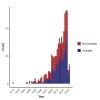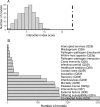Co-circulating pathogens of humans: a systematic review of mechanistic transmission models
- PMID: 40987329
- PMCID: PMC12457019
- DOI: 10.1098/rspb.2025.1453
Co-circulating pathogens of humans: a systematic review of mechanistic transmission models
Abstract
Historically, most mathematical models of infectious disease dynamics have focused on a single pathogen, despite the ubiquity of co-circulating pathogens in the real world. We conducted a systematic review of 326 published papers that included a mechanistic, population-level model of co-circulating human pathogens. We identified the types of pathogens represented in this literature, techniques used and motivations for conducting these studies. We also created an interaction index to quantify the degree to which co-circulating pathogen models include across scale and/or pathogen-pathogen interactions. We found that the emergence of new pathogens, such as HIV and SARS-CoV-2, precipitated modelling activity of the emerging pathogen with established pathogens. Pathogen characteristics also tended to drive modelling activity; for example, HIV suppresses the immune response, eliciting interesting dynamics when it is modelled with other pathogens. The motivations driving these studies were varied but could be divided into two major categories: exploration of dynamics and evaluation of interventions. Future potential avenues of research we identified include investigating the effects of misdiagnosis of clinically similar co-circulating pathogens and characterizing the impacts of one pathogen on public health resources available to curtail the spread of other pathogens.
Keywords: co-circulating pathogens; disease transmission; mechanistic modelling.
Conflict of interest statement
We declare we have no competing interests.
Figures







References
Publication types
MeSH terms
Grants and funding
LinkOut - more resources
Full Text Sources
Medical
Miscellaneous

